Chain-linked Socks Let You Walk on Nails and Glass
Table of contents
- SECTION 2 APPEARANCE (2-2-1)
- DEPORTMENT (2-2-1)
- HAIR (2-2-1)
- JEWELLERY (2-2-3)
- BODY ADORNMENT (2-2-3)
- UNDERGARMENTS (2-2-3)
- EYEGLASSES/SUNGLASSES (2-2-3)
- WEAR OF CLOTHING ITEMS (2-2-4)
DEPORTMENT
- Responsibilities. Pursuant to QR&O 17.02, the deportment and appearance of all ranks, in uniform or when wearing civilian attire, shall on all occasions reflect credit on the CAF and the individual. It is the responsibility and duty of all officers, warrant officers and non-commissioned officers to ensure that, by their vigilance, actions and example, the policies, regulations and instructions contained herein are adhered to by all ranks.
- Behaviour. Personnel in uniform shall comport themselves in a manner which projects a positive military appearance. Behaviour such as chewing gum, slouching, placing hands in pockets, smoking or eating on the street and walking hand in hand, is forbidden. This instruction's objective is to project an image of a disciplined and self-controlled force.
- Military Presence. Personnel in uniform shall be well groomed, with footwear cleaned and shone, and uniform cleaned and properly pressed. In particular, buttons, fasteners and zippers shall be kept closed; pockets shall not be bulged; items such as glasses, glass cases, sunglasses, pens, pencils, key rings or paper shall not be visibly extended nor protrude from pockets or be suspended from waist belts or pockets; personal cell phones that are conservative in appearance may be worn; headphones shall not be worn; ear buds may be worn when travelling on public transit only. CAF personnel wearing civilian clothes on military installations and in military groups or settings shall dress and comport themselves at all times as befits members of a disciplined, cohesive force.
HAIR
- Hair on the head shall be neatly groomed and conservatively styled. The length, bulk or style of hair shall not detract from a positive military appearance or preclude the proper wear of military headdress. (Bulk is the distance that the mass of hair extends from the skin, when groomed, as opposed to the length of hair.) In particular, style and colour shall not present a bizarre, exaggerated, or unusual appearance. Unusual colours, such as green, bright red, orange, purple, etc., are not permitted. Hair must be secured or styled back to reveal the face, and any accessories used to secure or control hair styles shall be as unobtrusive as possible. Hair ornaments shall not be worn, except women's conservative barrettes which blend with the hair colour. Shaving of all of the hair on the head is permitted. The personal manner of wearing hair within these general style limits, including moustaches, beards and braids, shall be modified to the degree necessary to accommodate operational or occupational equipment, such as gas, oxygen and scuba masks, hard, combat and flying helmets, etc., where a member's safety or mission is put in jeopardy.
- The following additional details apply to specific groups to accord with religious and spiritual practices and public perceptions of a disciplined force:
- Men (see Figure 2-2-1). Hair shall be taper-trimmed at the back, sides, and above the ears to blend with the hair-style; be no more than 15 cm in length and sufficiently short that, when the hair is groomed and headdress is removed, no hair shall touch the ears or fall below the top of the eyebrows; be no more than 4 cm in bulk at the top of the head, gradually decreasing to blend with the taper-trimmed sides and back; and be kept free from the neck to a distance of 2.5 cm above the shirt collar. Taper trimmed square back styles and shaving of all the hair on the head are permitted.
- Sideburns. Sideburns shall not extend below a line horizontally bisecting the ear, and shall be squared off horizontally at the bottom edge and taper-trimmed to conform to the overall hair style.
- Moustaches (see Figure 2-2-2). When moustaches are worn alone, the unshaven portion of the face shall not extend outwards beyond the corners of the mouth. Moustaches shall be kept neatly trimmed; not be greater than 2 cm in bulk; not extend below the corners of the mouth, not protrude beyond the width of the face when fully extended horizontally and worn in a waxed, handlebar style.
- Beards (see Figure 2-2-2)
CANFORGEN : 158/18 CMP 078/18 251819Z SEP 18- In accordance with the procedure established by the Chief of the Defence Staff, the wearing of a beard is authorized for all CAF members upon attainment of their operationally functional point or having completed the developmental period, whichever comes last.
- Commanders of commands, task force commanders and commanding officers retain the right to order restrictions on the wearing of a beard to meet safety and operational requirements. This includes restrictions pertaining to operations and training in a chemical, biological, radiological and nuclear (CBRN) environment or CBRN training environment.
- A beard shall be worn with a mustache; it shall be neatly trimmed, especially on the lower neck and cheekbones; and it shall not exceed 2 cm in bulk. A member will, on their own accord or upon direction from their commanding officer or commanding officer's designate, shave off unsuccessful attempts to grow a beard.
- The directions pertaining to the trimming of a beard at subparagraph 3c) and illustrated at Figure 2-2-2 only apply to members wearing a beard for reasons other than medical. Members with a medical certificate shall follow the directions therein and, if exempt from shaving, shall not shave the lower neck or the cheekbones. The unit will strictly comply with the requirement to monitor ongoing cases at a minimum of six-month intervals.
- Women (see Figure 2-2-3). Hair shall not extend below the lower edge of the shirt collar. Exaggerated styles, including those with excessive fullness or extreme height, are not authorized. Braids, if worn, shall be styled conservatively and tied tightly: secured at the end by a knot or a small unadorned fastener. A second small unadorned fastener may be used to secure the top of the braid. A single braid shall be worn in the centre of the back. Double braids shall be worn behind the shoulders. Hair shall be a maximum length when gathered behind the head and braided which does not extend below the top of the armpit. Multiple braids (cornrows) shall be directed toward the back of the head, pulled tight to the head and secured at the end by a knot or a small-unadorned fastener. A second small unadorned fastener may be used to secure the top of the braid. Multiple braids extending below the lower edge of the collar are to be gathered in a bun. Pony tail shall be worn in the centre of the back. Hair shall be a maximum length when gathered behind the head and does not extend below the top of the armpit. With the permission of a Commanding Officer, a reasonable period may be authorized in order to transition from short to long hairstyles, during which time hair may extend below the lower edge of the shirt collar; all the while maintaining a positive military appearance, and subject to the member's safety.
- Men (see Figure 2-2-1). Hair shall be taper-trimmed at the back, sides, and above the ears to blend with the hair-style; be no more than 15 cm in length and sufficiently short that, when the hair is groomed and headdress is removed, no hair shall touch the ears or fall below the top of the eyebrows; be no more than 4 cm in bulk at the top of the head, gradually decreasing to blend with the taper-trimmed sides and back; and be kept free from the neck to a distance of 2.5 cm above the shirt collar. Taper trimmed square back styles and shaving of all the hair on the head are permitted.
NOTE
Appearance on ceremonial parade in accordance with Figure 2-2-3; straight hairstyles will be gathered in a bun. This is also applicable for the cornrows.
- Aboriginal Members. Aboriginal CAF members whose spirituality embraces the wearing of hair braids and who have been granted permission in writing at the unit level shall be authorized to adopt traditional Aboriginal hairstyles. Although the member is not required to self-identify through the CAF Self-ID Census, the member must declare their Aboriginal spiritual requirement as either status or non-status First Nations, Inuit, or Métis in writing to their Commanding Officer and this declaration will be kept as Protected B on the member's personnel file. As long as there is no safety or operational concerns, a Commanding Officer will grant permission to the member and have it recorded on the member's original requesting memorandum. Upon posting to a new unit, the Aboriginal CAF member must re-seek permission from his new chain of command, as operational or safety concerns may have changed. For the transition from short to long hairstyle, hair shall not extend below the lower edge of the shirt collar and shall be styled neatly. Long hair that does extend below the lower edge of the shirt collar, and is not long enough to be braided, shall be gathered behind the head with a small unadorned fastener of a colour that blends in with the hair. As soon as the hair is long enough, braids shall be styled conservatively and tied tightly; secured at the end by a knot or a small, unadorned fastener. A second small unadorned fastener may be used to secure the top of the braid. A single braid shall be worn in the centre of the back and double braids shall be worn behind the shoulder, which does not extend below the top of the armpit.
Specific descriptions of hairstyles may change based on spiritual requirements of various Aboriginal groups. If Aboriginal CAF members request permission to grow their hair outside of the previously described policy, they must request specific accommodation through the CAF's Interim Policy on Religious Accommodation and CANFORGEN 162/12. Advice on this policy and declarations of appropriate spiritual practices may be obtained from the Directorate of Human Rights and Diversity (DHRD) or local/regional Defence Aboriginal Advisory Group (DAAG) Co-Chairs. Ultimately, the CAF encourages its Aboriginal people to embrace their culture and spiritual beliefs while proudly serving in the military.
- Adherents of the Sikh Religion. See Section 3 for qualifying details.
JEWELLERY
- The only jewellery that may be worn in uniform shall be a wrist watch, a service-issued ID tag, a Medical Alert chain identifier, a maximum of two rings which are not of a costume jewellery nature and a tie tack/clasp. Additional rings may only be worn where they indicate professional standing, such as an engineer, or are worn with a wedding band as a single set indicating betrothal or fidelity, e.g., an engagement or an anniversary ring. Safety regulations should always prevail, especially in workshops, warehouses or during operations.
- In addition, female members in uniform may wear a single pair of plain gold, silver stud, white diamond, or white pearl earrings in pierced ears. The single stud earring, worn in the centre of each earlobe, shall be spherical in shape and shall not exceed 0.6 cm in diameter. (For wear of white pearl earrings; see Chapter 5, Annex E.) No other type of earring shall be worn, except for a gold or silver stud healing device of similar shape and size, which may be worn while ears are healing after piercing. Only a single earring or healing device, worn in the centre of each earlobe, may be worn at a time (see Figure 2-2-3).
- Special instructions for cuff links and shirt studs worn with mess dress are given in Chapter 5, Annex E.
- Male personnel shall not wear earrings or ear-sleepers on the ears while in uniform or on duty in civilian clothes. When wearing civilian clothes off duty, jewellery and accessories will preserve a conservative, disciplined, professional appearance. See also paragraphs 1. and 3.
BODY ADORNMENT
- Make-up. Women may wear make-up for cultural reasons. When wearing uniform, or when wearing civilian clothes on duty, make-up shall be applied conservatively. This precludes the use of false eyelashes, heavy eyeliner, brightly coloured eye shadow, coloured nail polish, bright or vivid lipstick and excessive facial make-up.
- Body Tattoos and Body-Adornments.
- Tattos. The policy for tattoos has been recently amended. CANFORGEN 121/19 CMP 068/19 062030Z AUG 19 for direction and guidance on tattoos.
- Visible and non-visible body piercing adornments. with the exception of women's earrings and ear sleepers described in sub-paragraph 6.a., shall not be worn by members either in uniform or on duty in civilian clothing. The meaning of the term "on duty", for purposes of dress and appearance, is Interpreted in Chapter 1, paragraph 20.
UNDERGARMENTS
- Undergarments shall be worn under all orders of dress and shall be of an appropriate colour so as not to be visible through uniform items of clothing.
EYEGLASSES/SUNGLASSES
- Eyeglasses and sunglasses shall be conservative in design and colour.
- Subject to any restrictions which may be imposed by commanding officers on occasions of wear, the following sunglasses are authorized for wear with CAF orders of dress:
- Designated Duty Personnel. Personnel serving in aircrew, field and other designated positions may obtain from the CAF Supply System and wear:
- Sunglasses (aircrew) 6450-01-442-1950,
- Ballistic Eyewear 8465-20-001-4355,and
- All Personnel. Personnel who normally wear eyeglasses, may wear either conventionally framed prescription sunglasses or conservatively styled clip-on sunglasses, when conditions and circumstances dictate. Others may wear conservatively styled sunglasses which conform in general appearance to those previously noted.
- Designated Duty Personnel. Personnel serving in aircrew, field and other designated positions may obtain from the CAF Supply System and wear:
- The following types of lenses are not authorized for wear with CAF orders of dress:
- Photochromic. These lenses act as a light filter and possess the property of darkening when exposed directly to ultraviolet light and lightening when the ultraviolet is withdrawn.
- Mirrored. These lenses, also referred to as half-silver mirrors, have a highly reflective metallic substance deposited upon the surface of the lenses, thereby creating a mirrored effect.
WEAR OF CLOTHING ITEMS
- General. The following paragraphs give instructions for common items, both permanent kit and optional purchase items, (see Chapter 5, Annex E) worn with a variety of uniforms. Additional details are given in succeeding chapters which describe insignia and accoutrements, medals and honours, and individual dress orders.
- Headdress (see Figure 2-2-4)
- Cap, Service. The cap shall be worn by male members square on the head with the peak in line with the eyebrows. The black woven cap band shall be fitted with the seam in line with the front seam of the cap.
- Hat, Service. The hat shall be worn by female members square on the head with the brim parallel to the ground. The crown of obsolescent bowler-style hats shall not be indented.
- Beret. The beret shall be worn evenly on the head, with the sweatband 2.5 cm above the eyebrows, the badge centred over the left eye, and the crown pulled downward to the right. The break of the sweatband shall be worn centred at the back of the head, with no draw string visible.
- Wedge Cap. The wedge cap shall be worn on the right side of the head, centred front and back, with the front edge of the cap 2.5 cm above the right eyebrow.
- Toque. An environmental toque may be worn as an alternative winter headdress with ceremonial dress (No. 1 orders), service dress (No. 3 orders and No 5 Operational dress), with topcoats (gabardines) and parkas during winter dress periods. Toques shall be worn flush against the top of the head and turned up once to show either a 7.5 cm or a 10 cm fold according to the design of the toque, with the lower edge of the fold 2.5 cm above the eyebrows. According to the severity of the weather, the toque may be:
- worn up, square on the head and slightly angled towards the back; or
- pulled down at the sides and back to cover the ears.
- Yukon Cap. This item may be worn with numbers 1, 2, and 3 orders of dress with topcoats (gabardines) and parkas during winter dress periods. The cap is worn square on the head with the lower edge 2.5 cm above the eyebrows. The front fur flap is always fastened up to the body of the cap. According to the severity of the weather, the ear flaps may be worn up, secured with Velcro over the top of the cap, or pulled down to protect the ears and back of neck, with Velcro fastened under the chin. Hat badges are not to be worn.
- Winter Fur Cap Worn by RMCC Officer Cadets only as follows:
- Ear Flaps Up. Worn as for the wedge cap. The crown shall be creased front to back to produce an overall uniform height for the cap of 16 cm.
- Ear Flaps Down. The cap shall be worn square on the head, slightly towards the back, but not beyond the natural forehead hairline. Hair shall not be visible between the eyebrows and the edge of the hat.
- Turban, Service. The turban and cap badge shall be worn as detailed in Section 3.
- Hijab.This optional women's hair and neck covering is to be used by CAF female Muslim members . See method of wear Section 3, paragraph 22.
- Jackets, Service Dress, and Tunics, High Collared. Sleeves shall be roll-pressed with no creases. Jackets and Tunics shall be worn fully buttoned-up.
- Necktie. The necktie shall be knotted neatly using either a windsor or four-in-hand knot, (see Figure 2-2-5) and shall be kept tight. Conservative tie-pins or clips may be worn. See Chapter 5, Annex E. When the jacket is removed, the tie shall not be tucked into the shirt, except for safety reasons.
- Skirts.The skirt shall cover the kneecap completely, but shall not extend further than 5 cm below the bottom of the kneecap (with the exception of Muslim women's skirts).
- Hosiery
- Socks
- Black nylon socks shall be worn with shoes and oxfords, and may be worn with boots.
- Grey wool socks may be worn with boots.
- Hose
- Nylons, Plain Pattern Skin-Toned
- May be worn with oxfords or pumps, when a skirt is worn.
- May be worn with oxfords or pumps, when slacks are worn.
- Nylons, Plain Pattern Black. May be worn with oxfords or pumps, when slacks are worn, at no expense to the public.
- Nylons, Plain Pattern, Ivory. May be worn with Navy summer service dress No. 3B, at no expense to the public.
- Nylons, Plain Pattern Skin-Toned
- Socks
- Footwear
- Shoes leather, oxfords, pumps, and boots ankle shall be clean and shone at all times.
- Footwear shall be laced as shown in Figure 2-2-6.
- Overshoes, boots cold weather, or black toe rubbers (optional) may be worn as required and shall be kept clean.
- Outer garments
- Topcoats (gabardines) /Raincoats
- When carried, they shall be draped over the left arm.
- When worn, coats shall remain fully buttoned except for the neck button, which may be unfastened at the discretion of the wearer.
- When worn over a skirt, coats shall cover the skirt completely and shall extend 8 to 10 cm below the kneecap.
- Parka (Service Dress)
- This optional item may be worn with or without the hood during periods of winter dress.
- When worn, the zipper and dome fasteners shall be either fully closed to the neck, or opened only to the extent required to facilitate the wearing of a scarf.
- Environmental slip-ons shall be worn.
- Scarf. The scarf may be worn with the topcoat (gabardine), parka, and windbreaker jacket.
- Sweater. Sweaters shall be worn as illustrated in the figures of Chapter 5.
- Gloves, Leather, Black. Gloves, leather, black are worn when ordered or as required during cold weather.
- Mitts, Leather, Black (Plain). This optional item may be worn with topcoats (gabardines) and parkas during winter dress periods.
- Windbreaker Jacket (authorized patterns)
- When worn over the sweater, this optional item shall cover the bottom of the sweater completely.
- It shall be worn over all shirt collars.
- The zipper shall not be lower than 15 cm from the fully closed position.
- Environmental slip-ons shall be worn.
- RCAF Leather Jacket. This optional item may be worn by RCAF personnel in no 3b and 3c order of dress. May also be worn with flying suits, however, not on operations.
- When worn over the sweater, this optional item shall cover the bottom of the sweater completely.
- It shall be worn over all shirt collars.
- The zipper shall not be lower than 15 cm from the fully closed position.
- Metal, pinned rank shall be worn in each shoulder.
- Nametag with abbreviated rank, last name and flying or specialist skill badge will be worn on left breast. Members of a command team down to unit level may include their position on the name tag.
- Topcoats (gabardines) /Raincoats
- Accessories
- Purses (Women)
- When purses are carried, they shall be held in the left hand or suspended over the left forearm.
- When the purse is carried as a shoulder-bag, the strap shall be suspended from the left shoulder with the top of the purse not higher than waist level. The purse shall not be carried as a shoulder-bag with the strap shortened to handbag length.
- Umbrella. Umbrellas may be carried during periods of wet weather. They shall be of a plain pattern, black, with black, gold or silver trim, with a plain black carrying case and handle. They shall not be carried on parade.
- Backpacks, laptop cases, briefcases. When in uniform, civilian-pattern bags / cases shall be of a plain, conservative pattern and be dark in colour, e.g. dark blue, dark green or black. Bright colours (e.g. yellow, orange, red, etc.) are not considered appropriate. Seams, zippers and other components are to blend with the primary colour of the bags / case. Accessories of any type (e.g. pins, dolls, keys, running shoes, water bottles, etc.) shall not be attached to the exterior of the bag / case. Bags / cases shall only be used as follows:
- Carried in the left hand for all numbers 1 and 2 orders of dress;
- Carried in the left hand, or worn suspended either over both shoulders or the left shoulder for all orders of dress not identified in sub-Para (1).
- Purses (Women)
- Miscellaneous. Cummerbunds shall be worn with the pleated opening facing upward
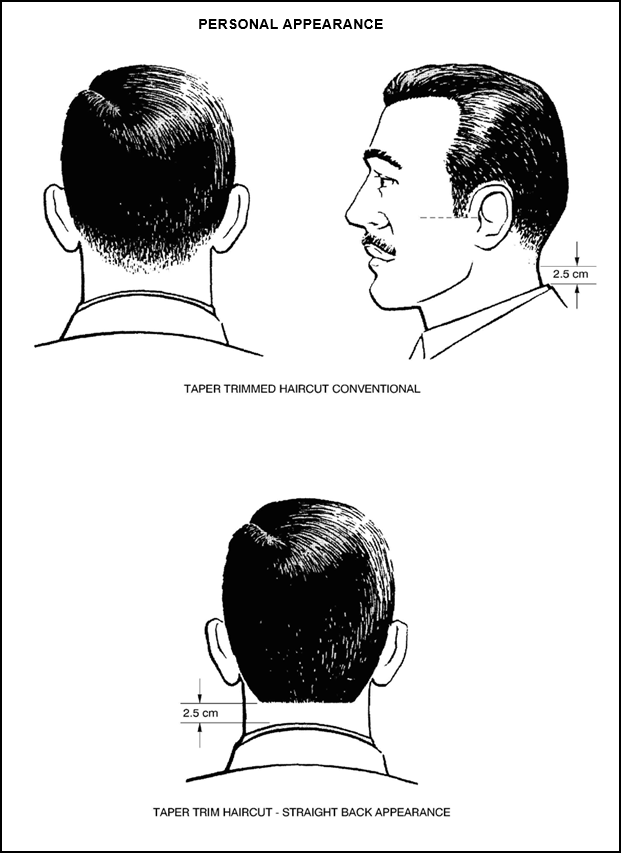
Figure 2-2-1 Male Personal Appearance
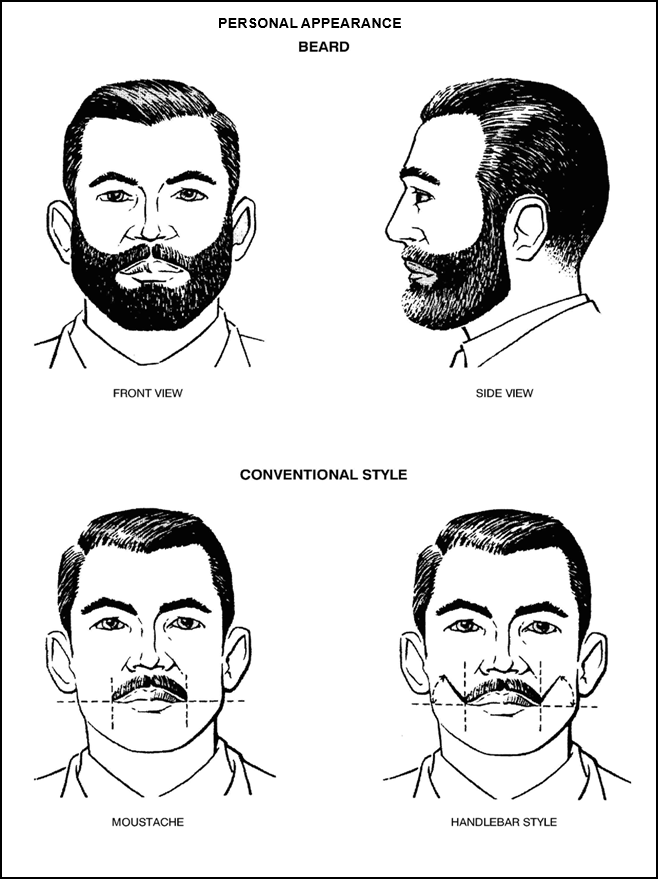
Figure 2-2-2 Male Personal Appearance
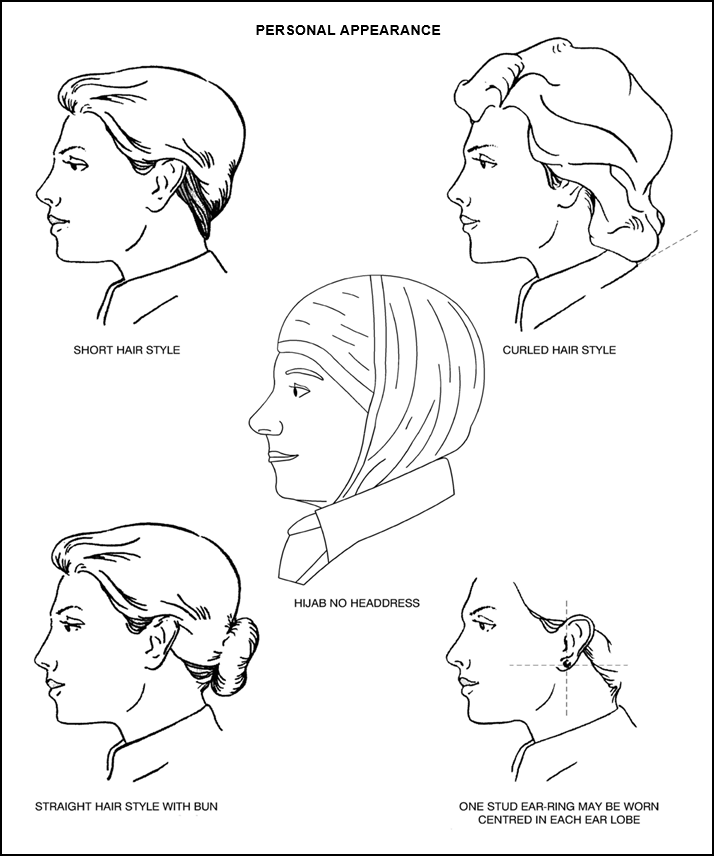
Figure-2-2-3 (Sheet 1 of 3) Female Personal Appearance is currently under review. For questions please click here.
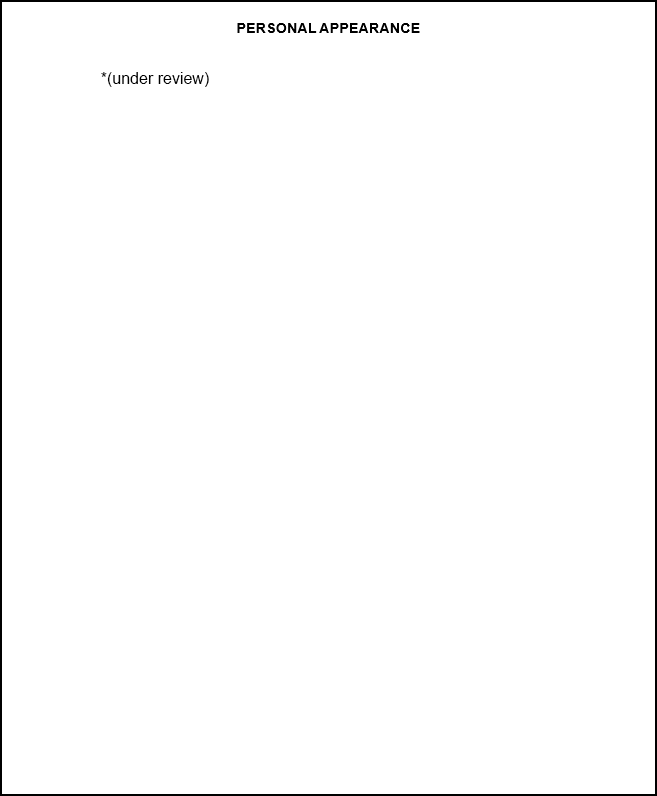
Figure-2-2-3 (Sheet 2 of 3) Female Personal Appearance
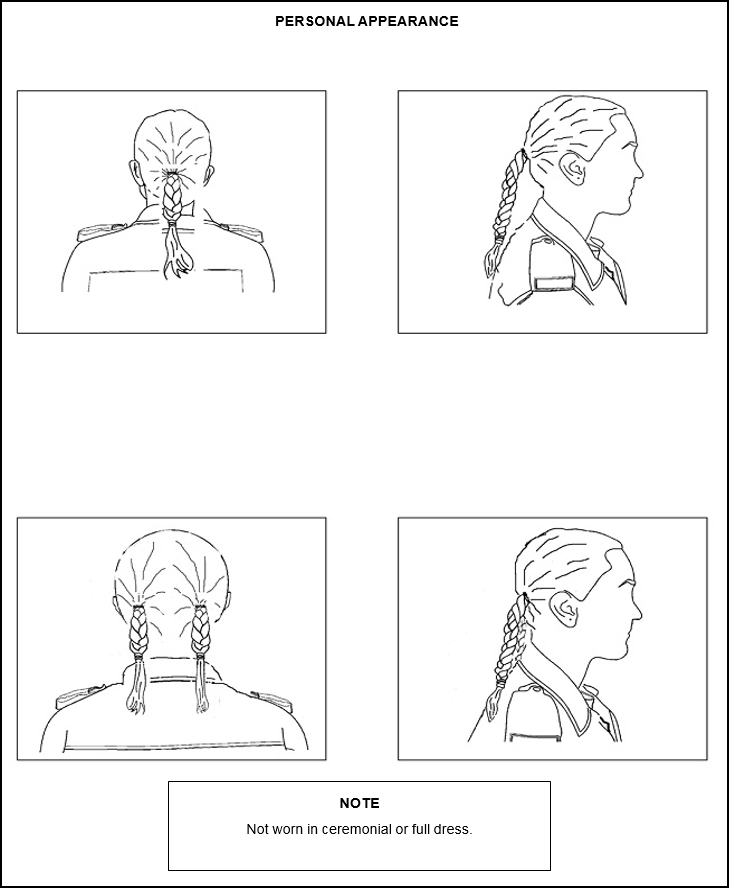
Figure-2-2-3 (Sheet 3 of 3) Female Personal Appearance
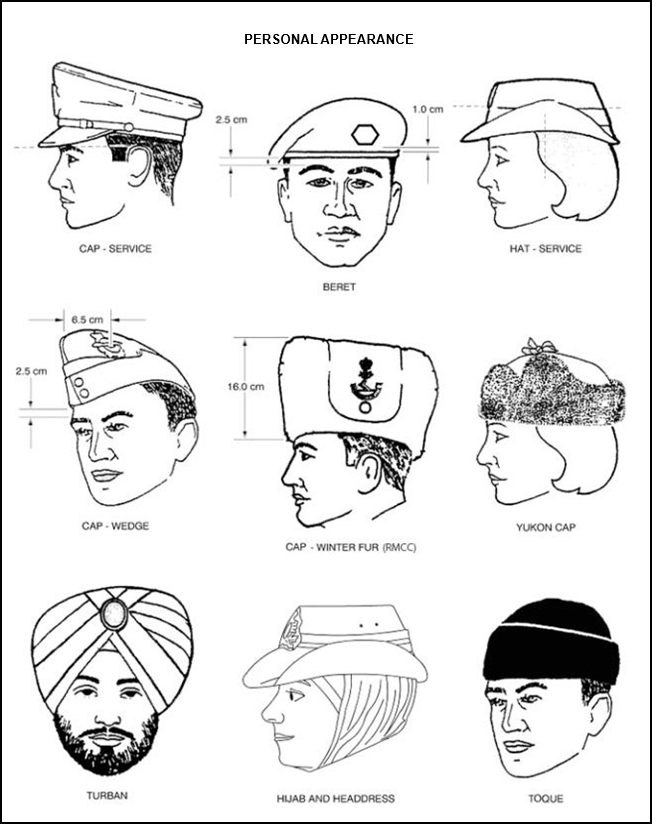
Figure-2-2-4 Wear of Headdress
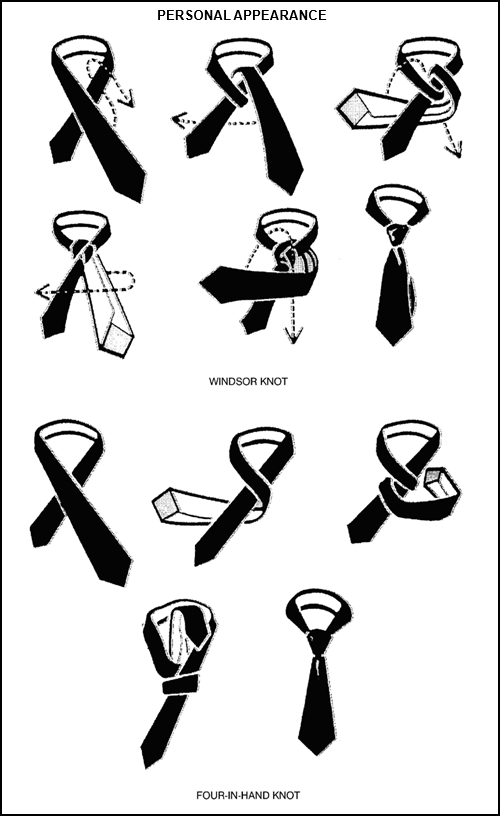
Figure-2-2-5 Knotting of Tie

Figure-2-2-6 Lacing Footwear
Description of Figure 2-2-6 Lacing Footwear
Footwear, if ankle boots or shoes, shall be laced using the Straight Across Method. There are no visible underlaces except at the top. Other footwear, such as combat boots, safety boots and lineman boots, shall be laced using the Herring Bone Method. Left boot lacing should be the inverse of right boot lacing, rather than each boot being laced identically.
Chain-linked Socks Let You Walk on Nails and Glass
Source: https://www.canada.ca/en/services/defence/caf/military-identity-system/dress-manual/chapter-2/section-2.html
0 Response to "Chain-linked Socks Let You Walk on Nails and Glass"
Post a Comment